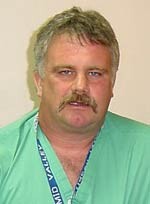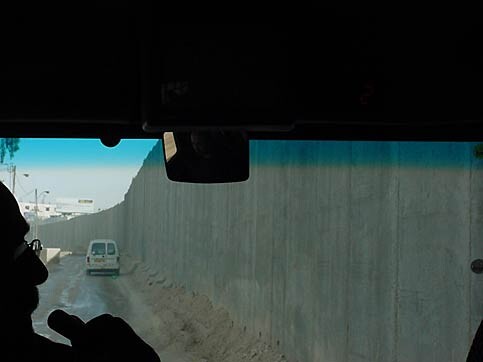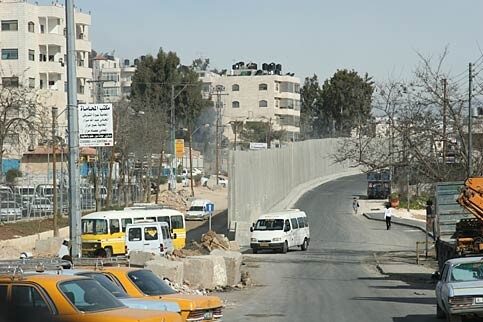Palestine 21 October 2005
Background

Our Washington State chapter has also taken on missions of “Citizen Diplomacy.” Our goal for this trip will be to meet with various prominent Israelis and Palestinians, and write reports on, “The Effects of the Occupation of the West Bank and Gaza on both the Occupiers and the Occupied.”
Our group of 19 members are about half physicians. I’m a rurally based Family/ER physician, and I am accompanied by a Cardiologist, a Urologist, a Child Psychiatrist, a Pediatric Neuro-developmental Specialist, a General Pediatrician, an MD/PhD Medical Student, who is also the current President of WaPSR, and 2 Radiologists from Switzerland.
The remainder of our delegation includes a Hospice Nurse, a Rural Mental Health Counselor, a University based Nurse Practitioner, a Genetics Counselor, a Linguist who works for Microsoft, a Canadian Medical Information Technology Specialist, an Artist, a Filmmaker, a Baptist Minister, and a prominent Jewish-American Peace Activist who lived in Israel for 5 years during the 1980’s. Our group collectively comes from Christian, Muslim, Hindu and Jewish backgrounds.
FROM THE SOUTHERN PALESTINIAN BANTUSTAN, ACROSS JERUSALEM TO THE NORTHERN PALESTINIAN BANTUSTAN
March 6, 2005, in Bethlehem, Jerusalem, and Ramallah
The delegation landed at Ben Gurion Airport near Tel Aviv at 2 am this morning, and made it up the hill to Jerusalem, then South though our first Israeli military checkpoint, arriving at 4 am local time at the Casa Nova Hotel in Manger Square in Bethlehem, about 200 feet from the Church of the Nativity. We are allotted 3 hours rest, and then begin our first day in the Holy Land ten time zones ahead of our circadian rhythm, which we left back in Seattle. We’re off!

The view north of Bethlehem towards Jerusalem. The Israeli settlement of Har Homa is under constuction in the distance. (Photo: Bob Haynes)
Our mission today will be to visit the Ramallah/El Bireh area in the Northern West Bank, which is now essentially sealed off from Bethlehem, in the Southern West Bank. Although Ramallah and Bethlehem are only 35 km apart, we must traverse two major Israeli military checkpoints in and out of Jerusalem to get there.
We are fortunate, for our delegation members carry American, Canadian, and Swiss Passports. We just flash them as the young Israeli soldier boards our bus, and he waves us through; a relatively minor inconvenience. Not so for your ordinary Palestinian. They risk humiliation, verbal and physical abuse, detention and may be turned back at any time. Our Palestinian guide has been unable to visit the Northern West Bank for over a year now. He is quite grateful traveling with us, so he can finally do so.

The Wall separating Al-Ram from Beit Hanina. (Photo: Bill Dienst)
We cross the Bethlehem checkpoint where we see The Wall in the daylight for the first time. We travel mostly across East Jerusalem, which was annexed by Israel after the 1967 Six Day War, violating the Geneva Conventions and international law. We see the Palestinian town of Al-Ram being walled off from its economic center in Jerusalem on 3 sides, becoming an Enclave or Ghetto. Finally we cross Qalandia checkpoint, the busiest checkpoint in the entire West Bank, and into Ramallah.

The Wall under construction, dividing Al-Ram from Beit Hanina. (Photo: Bob Haynes)
We arrive at the main Palestine Red Crescent Society hospital in El Bireh. The Palestine Red Crescent Society, or PRCS, initially evolved as the Palestinian health services in exile, its institutions developed in parallel with those of the PLO, and they have services in Lebanon, Syria, Egypt, Iraq, etc., where there are significant Palestinian refugee populations. During the Oslo years, the PRCS was allowed to set up services in the West Bank and Gaza. Its former leader Dr. Fathi Arafat died a month after his brother, in December, 2004.
We file into a meeting room and meet Sana Itayim, information officer of the PRCS. We also meet Dr. Hikmat Ajjuri and Dr. Abdul-Aziz-Al Labadi, who are current and former regional vice presidents of the International Physicians for the Prevention of Nuclear War (IPPNW). They share this position with Dr. Ernesto Kahan, an Israeli, whom we will meet later. We learn about the aging Dimona Nuclear Reactor, in Israel’s Negev desert, which is now over 50 years old, when most reactors are decommissioned after 40 years.
We are briefed on various current aspects of the occupation. Some highlights of our conversations were that the poverty rate in the West Bank has increased from 20% to over 50% during the past 4 years. In Gaza, the poverty rate is well over 70%.
We heard about the effects of the Wall; 85% of it is being built not on the Green line, but instead inside the West Bank. Although it is being billed as a means to protect Israeli’s from terrorist attacks, the reality is quite different. 274,000 Palestinians are left in a series of enclaves, and are cut off from their neighboring communities. Over 93,000 Palestinians will be trapped on the Israeli side of the wall. West Bank residents who are Palestinian are being separated from their communities, farmers from their farms, in a massive and illegal land grab. International — especially United States — support of Israel is relieving the Jewish State of the financial consequences of this occupation and is indirectly financing the building of the wall.
PRCS is finding it more difficult to transfer patients needing tertiary care services to the Palestinian Medical Center, Al Maqassed, in Jerusalem, since its ambulances are unable to pass through the Qalandia checkpoint, and Israeli ambulances want $200 to take the patient the additional 10 km to Al Maqassed.
Next, we are given a tour of PRCS hospital in El Bireh by Dr. Ziad Abu Assi, a pediatrician, who completed his residency through the State University of New York, before returning to Palestine to serve his people. PRCS-El Bireh has emergency room services, and is largely a maternity and pediatric hospital.

Arafat’s tomb in the Palestinian Authority district headquarters, Ramallah, 6 March 2005. (Photo: Bob Haynes)
Our delegation visits the grave of the late Yasser Arafat, and then the Palestinian Authority foreign affairs department, where we meet with Dr. Jauher Sayej, a member of FATEH, and head of Medical Administration for the Palestinian Authority, Adnan Samara, Vice President and Member of FATEH Revolutionary Council, and Mufid Abbid Rabbo, a member of the Palestine Legislative Council.
Dr. Sayej reviews studies about the psychology of Palestinian children. There are two groups, children who are directly harmed - wounded, imprisoned or hit by soldiers, and those that have been indirectly harmed, for example, those with a martyr in their family or those that have seen harm of their family or have had their house demolished and now must live without their house in a tent or with other families.
“This is a massive group. I was astonished by a drawing which my nephew drew - A martyr killed and the tank so little beside him. I visited his school. Asked the children what they want to be when they grew up - most said, “Martyrs” - this has a great effect on our psychology. So we have to consider this - teach the children to think about peace, to build their personality - to think to be engineers, some peaceful professions.”
Dr. Sayej also notes the change the children had in their personality. “They are challenging everyone - there are those challenging the tank; and because of this, they become heroes. So, how will this student listen to his teacher in his school? Teach them to play with cars, not guns - not to make army - not to make martyrs - this is our dream about the future of our children.”
Then there is the impact on the children who are harmed, for example, children who lose a leg: “They are heroes, they are wounded. But at night, they weep and cry. They feel themselves disabled - during this complex of discussion, the other thing is to see his father hit by soldiers - how he will feel towards his father - towards his parents. Do you love the Jews? Most of the children say, ‘Only the Jewish children - not the soldiers.’”
Adnan Samara adds that the most adverse effect on the psychology of Palestinian children is the humiliating treatment of their parents at the checkpoints. This can be a major influence for some to be violent. When you study the background of the children who do these acts, every one has direct personal problem with the Israeli Occupation, his land, humiliation of his parents, etc
Tomorrow, we will visit members of the Israeli peace movement in Jerusalem: The Israeli Committee against House Demolitions, Rabbis for Human Rights, Palestine-Israel Journal, and Machsum Watch.
Dr. Bill Dienst is a rural family and emergency room physician from Omak, Washington, USA. In March 2005, he traveled to Palestine and Israel as part of a delegation sponsored by Washington State Physicians for Social Responsibility (WaPSR). The delegation met with prominent Palestinians as well as members of the Israeli peace movement. They also traveled inside the Kiryat Arba’a settlement to hear a prominent member of the settler movement. In this series of articles, Dr. Dienst describes these meetings. Dr. Dienst has been to Israel-Palestine twice before. In November 2003, he spent 10 days in Gaza sponsored by Gaza Community Health Programme, and in 1985, he spent 4 1/2 months in Egypt the West Bank and Gaza sponsored by the Palestine Red Crescent Society.





